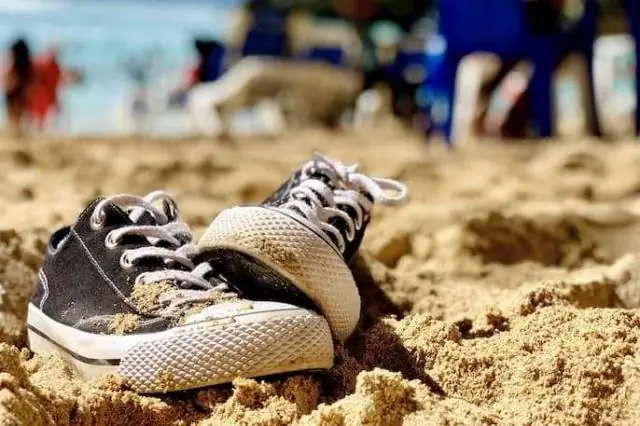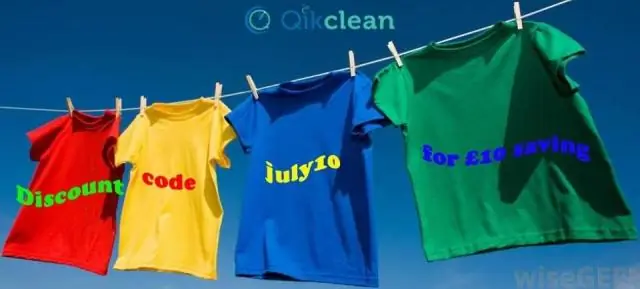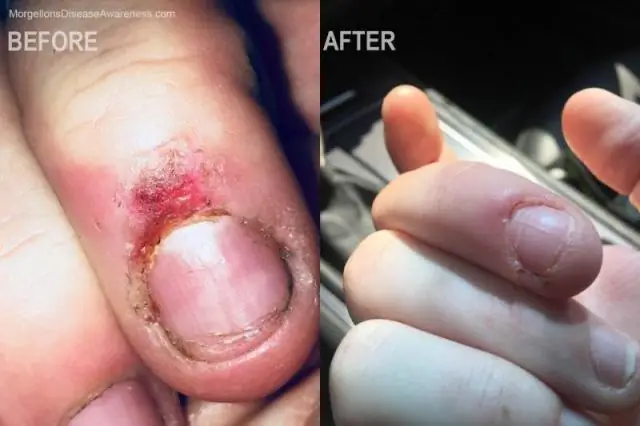
Table of contents:
- Author Bailey Albertson [email protected].
- Public 2023-12-17 12:53.
- Last modified 2025-01-23 12:41.
How to remove 9 glue stains from clothes

Even tough stains such as glue stains are not at all a reason to say goodbye to the product. You just need to figure out the type of glue and the type of fabric on which an unaesthetic mark has formed, and then choose the appropriate way to remove the dirt.
Content
- 1 Why is glue difficult to remove from fabric
-
2 Methods for removing all popular types of glue from fabrics of different textures
-
2.1 How to clean Superglue
- 2.1.1 Removing stains with white spirit, kerosene, gasoline or acetone
- 2.1.2 Cleaning stains with vinegar
- 2.1.3 Removing Super Glue Stains with an Iron - Video
-
2.2 Methods for Removing Titanium Glue Stains
- 2.2.1 Using nail polish remover
- 2.2.2 Removing stains with nitromethane or Dimexide
- 2.3 How to remove PVA stains from fabrics
-
2.4 Methods for removing silicate glue stains
- 2.4.1 Using laundry soap
- 2.4.2 Removing stubborn stains
- 2.5 Removing Casein Glue Stains
- 2.6 How to clean hot glue stains
- 2.7 How to remove traces of textile glue
- 2.8 Removing glue stains Moment
- 2.9 How to remove vegetable glue stains
- 2.10 Video: three ways to remove glue stains from clothes
-
- 3 What not to do
Why is glue difficult to remove from fabric
The purpose of the glue is to adhere the fibers of the materials to firmly bond the surfaces. And this substance performs its function with a bang, but completely without understanding the type of these same fibers. If a drop of glue hits the fabric, then the threads are quickly connected firmly. Returning flexibility and freedom to them is not easy. The mark will not only be very noticeable, but also noticeable: the fabric will lose its softness and elasticity at the spot. Over time, the dried glue will begin to crumble, and it will do this together with the fibers of the fabric - in other words, a hole will form.
Superglue connects objects faster and stronger, so it is more difficult to remove it from fabrics. And the most removable types are PVA and pencil. The form of release of the latter makes it quite easy to remove the connection from the fibers of the fabric, and all because the thick consistency allows mechanical rolling of dirt.

Before using special products, you must familiarize yourself with the recommendations for the type of fabric with which the trail will be displayed.
Methods for removing all popular types of glue from fabrics of different textures
The type of connecting substance determines how quickly the glue dries, how easily it can be removed from clothes.
How to clean Superglue
This glue has won our hearts for its ability to dry quickly and reliably glue almost any surface. Ways of dealing with stains from him require heavy artillery or the use of Anticlea.

Superglue sets very quickly
Removing stains with white spirit, kerosene, gasoline or acetone
Such strong substances can only be used on natural non-colored fabrics:
- We moisten a cotton pad in the chosen product.
- We wipe the dirt.
- We leave for 30 minutes.
- We erase the thing in the usual way.
If the stain is very old and does not give in, then the procedure can be repeated 2-3 times.
Cleaning stains with vinegar
The method is suitable for removing stains even from delicate fabrics. But on denim, vinegar may not give the desired result. Instructions:
- We breed 1 tbsp. l. table vinegar in 1 glass of warm water.
- We soak the item for 40-50 minutes or apply the solution to the dirt if the item is large.
- We erase in the usual way.
Removing Superglue stains with an iron - video
Methods for removing titanium glue stains
You can try to remove stains mechanically:
- Lay out the product with a stain on a hard surface.
- Cover with gauze on top.
- With the blunt side of a knife or a hammer, knock on the dried glue.
- We remove the leftovers. A nail file is suitable for this purpose.

If you freeze a Titan stain, then you can simply clean it off.
Using nail polish remover
This acetone-based product perfectly removes glue stains from fabrics made from natural and artificial fibers. Determine the degree of compliance of the latter can only be empirically, by conducting a test on an inconspicuous area. You can replace the liquid with an acrylate softener (sold with nail extension products). There are two ways to influence pollution:
- pour over the stain with a product (if the fabric is light);
- soak the stained area with a cloth soaked in nail polish remover or softener (if the cloth is colored or dark).
The remaining trace should be wiped off with a cotton cloth and washed in the usual way.

Even unnatural colored fabrics can be treated with nail polish remover, but only after a preliminary test
Removing stains with nitromethane or Dimexide
Nitromethane is a dangerous substance. And not only for the fabric itself (these should be dense natural materials of light shades), but also for the skin of the hands. So you need to work with nitromethane only with gloves.
Dimexide does an excellent job of dissolving stains of various origins:
- Moisten a cotton swab with a product.
- Wipe off the trail.
- Clean the stained area with a sponge or brush.
- Wash in warm water.

Dimexide is a versatile product that can be used to remove glue marks from any fabric
How to remove PVA stains from fabrics
This is the most common type of glue stain, especially on children's clothes. Fresh stains can be removed by regular washing with preliminary soaking in warm water with powder. If the stain on the natural fabric is very large and old, then the PVA trail can be wiped off with a cotton swab moistened with alcohol, left for 30 minutes, and then washed.
Remove stains from suede with steam:
- Hold the thing over the steam for 2-3 minutes.
- Wipe off the softened glue mass with a napkin.
To clean silk, the product must be placed in the freezer, and then the dirt must be crumbled and the residue removed from the fabric.

Fresh stains from PVA glue can be simply wiped off
Ways to remove silicate glue stains
This glue is called "liquid glass" for its transparency and adhesion strength. A type of silicate is clerical (office) glue. The peculiarity of the traces from it is that the substance, penetrating even deep into the fibers of the fabric, does not stick them together.

Silicate glue, getting on clothes, does not stick together fabric fibers
Using laundry soap
You can remove silicate glue stains with laundry soap:
- Soak the item for 3-4 hours.
- We rub the stain with laundry soap.
- If the fabric is not thin, then three with a brush.
- We rinse the product in clean water.

After using laundry soap, rinse the item well, otherwise the smell will remain
Removing old stains
Old stains can be removed from the cloth using baking soda and washing powder:
- Dissolve 2 tbsp in 3 liters of warm water. l. washing powder.
- Add 3 tbsp. l. baking soda.
- Soak the item for 3-4 hours.
- Three non-delicate fabrics with a brush.
- We rinse the product 2-3 times in clean water without powder.
Removing Casein Glue Stains
The substance is used for gluing wood, porcelain, cardboard, leather, ceramics. To remove stains from it from tissues, glycerin or ammonia is useful:
- Soak a cotton pad in the chosen product.
- Saturate the stained area.
- Rub with a brush (only if the fabric is natural or heavy), then wash as usual.
The casein glue is removed from jeans with gasoline. After such processing, the thing must be well washed and rinsed, otherwise the smell may remain.

Casein glue can be removed from fabric with gasoline
How to clean hot glue stains
When heated, this type of glue becomes liquid. It is distributed over the surface with a special pistol, but often drops from the spout of the device drip onto clothes. In this case, you need to put the thing in the freezer, and after freezing, break the glue remnants and remove them with your fingers or with a blunt knife (if the fabric is thick). You can also work on hot glue by heating (if the type of fabric tolerates high temperatures):
- We lay the place of pollution from above and below with pieces of cotton fabric.
- Iron the stain for 20 seconds. During this time, the adhesive will come off the lining.

Hot melt glue is charged into a special gun, from where it can accidentally drip onto clothes
How to remove traces of textile glue
With this tool, applications are glued to fabric, rhinestones and other decorative elements. Since the properties of a sealant, varnish and glue are combined in it, you will have to use gasoline, solvent, and white spirit. For delicate fabrics, it is better to use professional products or nail polish remover.
Removing glue stains Moment
From synthetics, the glue is wiped off with a cotton pad moistened with purified gasoline or acetone. For natural materials, the process is a little more complicated:
- Dissolve 1 tbsp. l. citric acid in 0.5 l of water.
- Apply the solution to the dirt using a soft cloth.
- After processing, we wash the thing in the usual way.

To remove the Moment glue from the fabric, it must be dissolved
How to remove plant glue stains
Such funds are made on the basis of starch, rubber, resin. They are used for gluing paper. If one of the most famous vegetable adhesives - rubber, has got on your clothes, you can moisten the place of contamination with gasoline, sprinkle with talcum powder and leave for 3-4 hours. After that, the thing must be washed. The reaction of colored fabrics to stain removers must be tested.

You can remove the stain from rubber glue with gasoline
To remove stains from other types of vegetable glue from clothes, you need to do the following:
- Mix 2.5 tbsp. l. filtered water, 1 tbsp. l. 95% alcohol and 10 g of soda ash.
- Treat the stained area with a cotton pad dipped in the solution.
- Wash a thing.
Video: three ways to remove glue stains from clothes
What not to do
The sooner you start to fight the glue stain on the fabric, the more likely it will disappear without a trace. But there are actions that are not recommended. When cleaning fabrics from glue, you must not:
- use any means without agreeing with the rules for the care of a particular type of fabric;
- forget that before using any product, it must be tested on an inconspicuous area;
- exceed the duration of the cleaning composition, otherwise the material of the product may be damaged.

It is possible to mechanically remove the glue stain only after preliminary processing of the fabric.
Removing a stain from one or another type of glue from different fabrics is easy if you choose the right way to clean the materials. There is a whole set of special and folk remedies to eliminate pollution of a similar origin. By choosing them to match the type of fabric, the type of glue and the degree of freshness of the stain, you will cope with the task.
Recommended:
How To Remove An Unpleasant Odor From Shoes At Home - Using Various Methods + Photos And Videos

Causes of unpleasant odors in shoes. How to remove the "odors" of sweat, glue, animal tags. Practical tips and recipes for home use
How To Remove Rust From Clothes At Home, How To Remove Stains From It From Various Types Of Fabric

Methods for cleaning clothes from rust using stain removers and home remedies. Features of removing rust stains for various materials
How To Remove Fuel Oil From Clothes At Home And How To Remove Stains From It From Various Types Of Fabric

How to remove fuel oil from clothes at home. Tips for using proven self-cleaning products for various types of fabrics. Video
How To Remove The Second-hand Smell From Clothes, How Can It Be Removed From Clothes, Washing Methods

How second-hand clothes are processed. How to get rid of the smell from different types of clothing bought in second-hand stores. How to remove odor from shoes
How To Remove Iodine From Clothes And Other Surfaces, Than To Wash It From The Skin, Various Methods And Means + Video And Photo

How to remove iodine from different fabrics, wash stains from furniture, body and other surfaces. Effective ways with instructions for use with photos and videos
